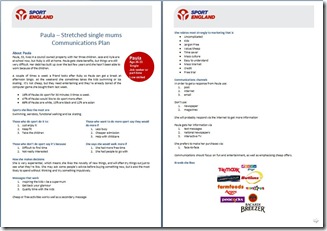 The communication plans have been updated and improved and are now live on promotingactivity.com.
The communication plans have been updated and improved and are now live on promotingactivity.com.
The communication plans are by far the most used part of www.promotingactivity.com. And for good reason – they’re fantastic. They’re based on the Sport England and Department of Health segmentation – the most advanced segmentation work this country has ever seen. And possibly the best in the world (certainly the best that I know about).
On top of that amazing research we’ve just completed a £100,000 qualitative research project (done by the awesome Futures Company) to find out what messages are going to work when marketing to each segment.
No longer do we need to guess what messages we should use in our marketing. We know.
How we did it
We knew that when you gather people together in a focus group and ask them why they don’t do more activity they think about it for a moment, then start lying to you. We’ve seen this for years, so this time we took a different approach.
We started with people who were interested in doing activity, but never got around to it. Not people who were vehemently opposed to the idea. And not people who were already active. But that large group of people who always mean to do more activity, but never quite get round to it. (NB – our research shows that this makes up about 30% of the population).
Firstly we asked these people to keep a scrapbook of how they felt about activity. Why they liked it. Whey they hated it. What some of their memories of it were. To cut out pictures from magazines that represented the kind of activities they’d like or dislike. We started to get some really good insight from this stage. When people were away from the social pressure of a focus group they started giving us some really truthful explanations of their attitudes to sport and activity.
Secondly we moved away from just thinking about activity, and into actually doing it. If Kev said that he’d like to join a football club then we asked him to join a football club. If Elaine said she’d like to start walking to work, then we asked her to try walking to work. If Terry said that he’d like to cycle to see his son then . . . . well, you get the idea.
After this, people let us know what that was like. What were some of the problems? What did they like about it? Would they do it again? This gave us some amazing insight – we really felt that we were getting inside these people’s skins, that we were starting to understand them.
Next we used all these insights in a mammoth marketing brainstorming session to come up with propositions (ideas, messages, and test adverts) that we thought would appeal to these people. We mocked these up and showed them to our audiences in groups. Some of these propositions worked brilliantly, and some completely flopped. We ditched the ones that flopped and kept the ones that worked.
And that’s what’s left for you. The propositions that worked. The messages that stood the test. The results of all this work, this insight, this testing and this refining. We’ve now taken all those messages that worked and have put them in pride of place in the communication plans.
And if you want to see the research reports themselves then they’re online too.
